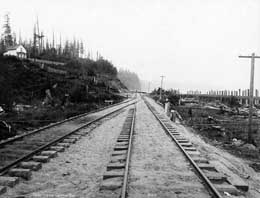On June 18, 1893, the first Great Northern Railway passenger train leaves Seattle for St. Paul, Minnesota. The departure marks the beginning of direct transcontinental rail travel from Seattle, fulfilling a goal that boosters and civic leaders have dreamed of for decades.
Building a Path West
Beginning in the late 1880s, Great Northern president James J. Hill (1838-1916) struggled to bring his transcontinental rail service to the Pacific Northwest from his home base in St. Paul, Minnesota. Hill was courted and aided in his efforts by many Seattle leaders, chief among them Judge Thomas Burke (1849-1925), lawyer, real-estate speculator, and one of Seattle's most influential citizens, who became Hill's local agent.
From the time it was founded, residents of Seattle, like those of nearly every settlement in Washington Territory, had dreamed that their town would become the terminus of a transcontinental railroad and thus the leading city of the region. Seattle's initial hopes were dashed in 1873, when the Northern Pacific line made Tacoma, not Seattle, its transcontinental terminus. Burke and other Seattle leaders responded by building local rail lines (none of which got very far) and battling the NP, which eventually built a neglected and inconvenient branch line to Seattle, over the generally poor service it provided the city.
Hill and his Great Northern provided a welcome alternative to the Northern Pacific, and Burke made sure that the city granted Hill the right-of-way and other concessions required for him to make Seattle the Great Northern's terminus. By 1892, Hill's workers had traversed the Rocky Mountains, using the 5,214-foot Marias Pass, but the Cascade Mountains proved to be more formidable. After constructing a circuitous series of switchbacks over Stevens Pass, the line reached Seattle in early 1893.
The first freight train arrived in Seattle along the line in February 1893, as the railway prepared for its inaugural passenger run. On June 6, 1893, Great Northern officials assured the public that the line was ready, and that the only place that they were still doing track work was raising the track on the Snohomish River flats between Lowell, just south of Everett, and Snohomish a few miles southeast. Snow sheds were still being built in the mountains, but those wouldn't be needed until later in the year.
On June 7, a lavish celebration was held in St. Paul in honor of the Great Northern's accomplishment. Plans were originally drawn up for celebrations in each city along the route, but a joint committee decided to hold a big "Hill Demonstration" in Minnesota instead. Thousands lined the streets of St. Paul to enjoy a grand parade, and a reception was held for Hill and other Great Northern officials.
A Humble Beginning
Eleven days later in Seattle, there was no formal celebration when the first Great Northern passenger train departed the depot at the foot of Marion Street at 8:15 a.m. on June 18, although a small crowd let out a mighty cheer when the train left for its 69-hour trip to St. Paul. That same day, another train left St. Paul heading west. Two passengers aboard the eastbound train were to meet the westbound train and return on it.
The train from Seattle was loaded with passengers, although some were only going as far as Spokane. Only 20 or so people were making the full trip to St. Paul, including Seattle developer E. F. Blaine and his wife, who planned to travel on to Chicago to attend the 1893 Columbian Exposition.
Other than the engine -- which was brand new -- the train was made up of old equipment. It consisted of a baggage car, two coaches, a dining car, and a sleeper. After leaving Seattle, it picked up a few more passengers in Everett.
The Lavish Follow-up
The westbound train arrived in Seattle on June 22, and was much more luxurious then the one that had left four days earlier. Those traveling east would now be riding in style. This train consisted of a baggage and express car, two day coaches, a dining car, a buffet car, a sleeper, and the private car of Great Northern General Superintendent C. Shields. The sleeper car -- named Seattle -- was finished in polished oak, as was the dining car, and both had velvet-plush seats, brass rods, and damask hangings.
The day coaches were more utilitarian, but the buffet car drew the most attention. It was 60 feet long, furnished in golden polished oak, and designed for a pleasant and restful trip. The main part of the car was a large sitting room, containing a dozen easy chairs padded with overstuffed cushions. A large table held a selection of newspapers and periodicals. A small barber shop was on board, in case the traveler wanted a haircut or a shave, and a few small tete-a-tete rooms offered a chance for private conversations.
The buffet car also had a small library, filled with books ranging from "Gibson's Decline and Fall of the Roman Empire to a French novel that will curl the hair like a blast from the Great Northern locomotive on a Montana prairie" (Seattle Post-Intelligencer, June 23, 1893). A writing desk was also available, for penning letters to family and friends about the sumptuous trip being undertaken across America.
Those first Great Northern passenger runs from Seattle were just the start. By 1911 there were a total of four transcontinental rail lines serving the city.

